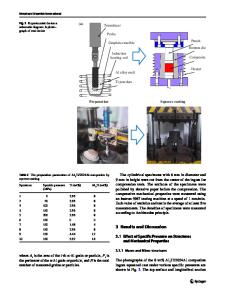Strengthening phases in the production of Al 2024 -CNTs composites by a milling process
- PDF / 543,306 Bytes
- 6 Pages / 612 x 792 pts (letter) Page_size
- 25 Downloads / 219 Views
Strengthening phases in the production of Al2024-CNTs composites by a milling process. R. Pérez-Bustamante1, F. Pérez-Bustamante2, J. M. Herrera-Ramírez1, I. Estrada-Guel1, P. Amézaga-Madrid1, M. Miki-Yoshida1, R. Martínez-Sánchez1 1
Centro de Investigación en Materiales Avanzados (CIMAV), Laboratorio Nacional de Nanotecnología, Miguel de Cervantes No. 120, C.P. 31109, Chihuahua, Chih., México. 2 Instituto Tecnológico de Chihuahua (ITCH), Av. Tecnológico No. 2909, C.P. 31310, Chihuahua, Chih., México. e-mail: [email protected] ABSTRACT Carbon nanotubes (CNTs) synthesized by a chemical vapor deposition (CVD) method and the 2024 aluminum alloy (Al2024) are used in the production of Al2024-CNTs composites. An homogeneous dispersion of the CNTs into the aluminum matrix is achieved by a mechanical milling processing. CNTs keet their morphology after milling and sintering processes. Formation of aluminum carbide as a function of CNTs contents is observed. Formation of equilibrium phases during sintering is observed by electron microscopy. CNTs and aluminum carbide in the composites are characterized by transmission electron microscopy. Hardness results of sintered products show an increment of up to 285% over the unreinforced alloy prepared by the same route. INTRODUCTION The wide use of aluminum alloys in several industrial fields has attracted the attention of a great number of researchers focused in the improvement of their mechanical properties [1-5]. The 2XXX and 7XXX series are of special interest because their mechanical enhancement lies in the precipitation of phases into the aluminum matrix during heat treatments. Additionally to the conventional routes used to fabricate these alloys, mechanical alloying (MA) offers the possibility for their production. This technique is widely used for the dispersion of strengthening phases, like nanoparticles or nanofibers, whose function is to get an increment in the mechanical behavior of an alloying system [6, 7]. In this regard, CNTs have emerged as a promising reinforcement media since their discovery in 1991 for the production of metal matrix composites. Nevertheless, research on this topic has received only modest attention. One of the main reasons is the lack of a good dispersion technique of CNTs into the metal matrix by conventional metallurgy. However, this problem can be solved by the use of MA. Works carried out about these topics demonstrate that the composites mechanical performance improve when the CNTs dispersion is achieved by milling processes [8-13]. EXPERIMENTAL PROCEDURE CNTs prepared by chemical vapor deposition (CVD) are used as reinforcement material in order to produce Al2024-based nanocomposites. Table I shows the composition of the Al2024 matrix prepared from pure elemental powders. Different CNTs concentrations are studied: 0.0, 0.5, 1.0, 2.0, 3.0, 4.0 and 5.0 wt. %. The milling time is varied to achieve the CNTs dispersion to
5, 10, 20 and 30 h. Table II shows the identification code for alloys and composites in this investigation. E
Data Loading...











